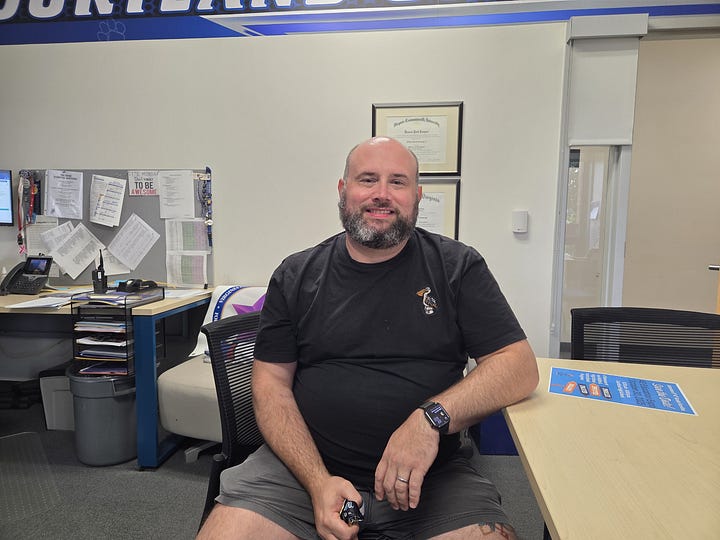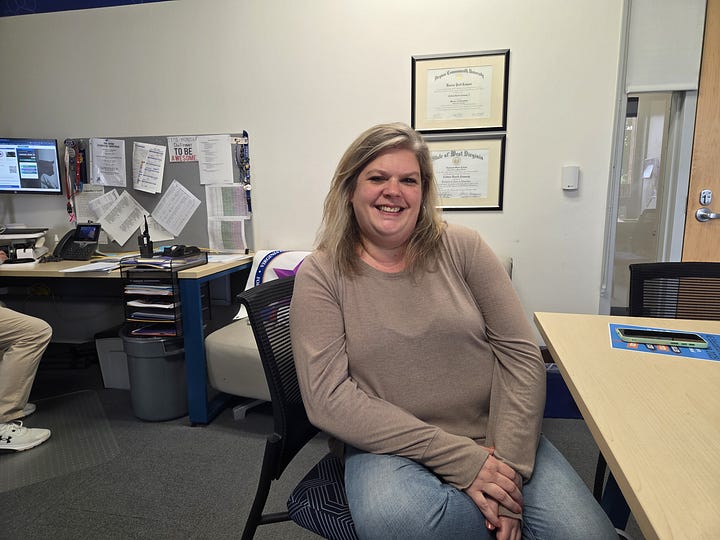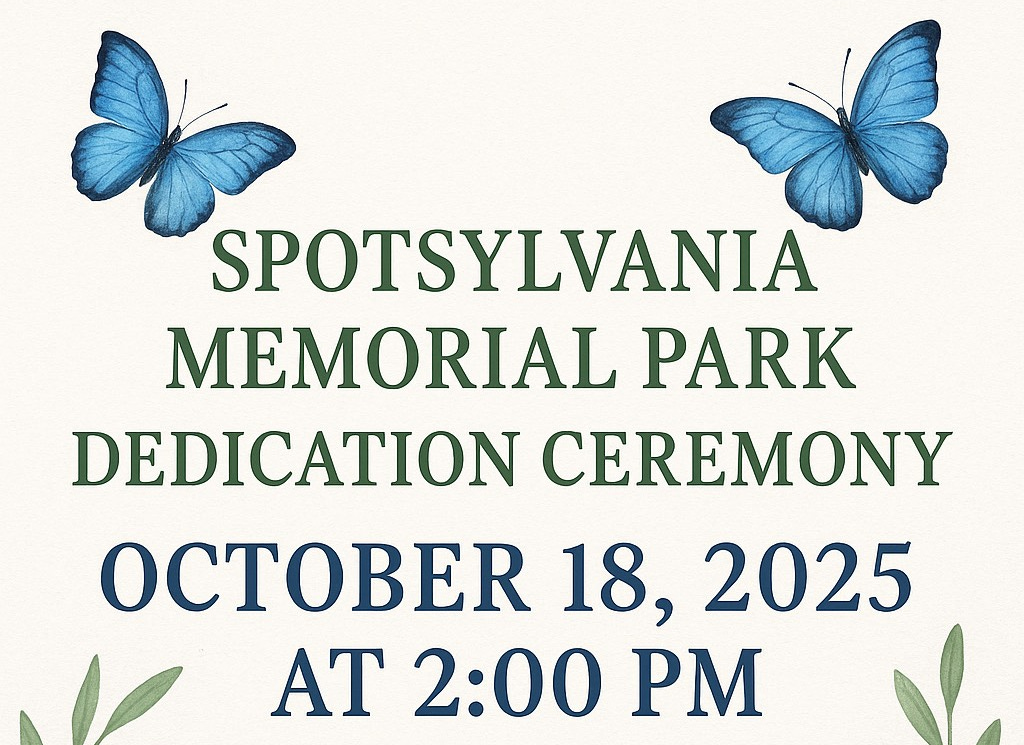At Courtland High School, Education is a Generational Effort
School's culture owes a great deal its faculty and staff, one-third of whom are themselves Courtland graduates.
By Martin Davis
EDITOR-IN-CHIEF
Email Martin


Spotsylvania’s demography is a tale of two regions — one rural and agricultural, one urban and diverse. What unites the two regions, however, is pride in each area’s local schools.
At one school in rapidly urbanizing Spotsylvania, however, that pride is felt in more than turnout on Friday nights at football games or displays of school colors and gear.
It is demonstrated in the willingness of school graduates to return to their alma mater and give to their students what their teachers gave to them — a passion for learning and the tools to build a successful life.
Welcome to Courtland high School, where 27 of the 91 teachers on staff are Courtland graduates.
A Closeknit Community
When Cliff Conway arrived a decade ago as principal of Courtland, he inherited a staff that was already benefitting from faculty who returned to teach.
“When I got here,” he told the Advance, “there were about 10 staff members who were graduates from here.” He quickly learned that they made for good faculty and staff members. “They wanted to be here as a part of Courtland,” he said. They were “focused and recognized the school as something important.”
That early experience didn’t set Conway on a mission to intentionally hire Courtland graduates, but it did give him insights into the distinctive gifts they bring to the school community.
“There is a tightness here at Courtland,” he said. “We have a lot of family members that show up here with long lineages with the school.”
Courtland is the second oldest high school in Spotsylvania and is currently in its 45th year of operation.
In a twist of irony, the surrounding community’s rapid growth and diversification has likely helped tighten the bonds that the community feels for the school by keeping the physical footprint the school serves, small. “We [have] a very small [physical] footprint,” Conway said, because the population density in Courtland’s district is the third highest in the county.
That bond likely is responsible for the school’s success. Courtland’s demographic profile is one that some would say is “challenging.” The school’s economically disadvantaged population is 45% of the total student body, said Conway. The student population is also majority-minority, according to data from U.S. News & World Report.
What proves challenging for some, however, it isn’t a problem at Courtland, which Conway says is “a strong school when it comes to accreditation and standards. [We are also] strong testing-wise.”
Virginia Department of Education data bears out that analysis. According to the data available on the VDOE website (new data is due in coming weeks), Courtland students attend class, with no subgroup having chronic absenteeism issues. In reading, all student subgroups save special education students are meeting state annual targets, with Hispanic students showing statistically significant growth over the prior academic year.
Also keeping the community bonds strong are the teachers. With nearly a third of the faculty Courtland grads, they understand the culture and opportunities the school offers.
Expanding the Family
Amy Thorne is as close to a Courtland lifer as one can be. She attended Courtland all four of her high school years, attended what was then Mary Washington College, and was scheduled to return to Courtland for her student-teaching in 2001.
“Instead,” she said, “I was asked to join as a full-time teacher. Fall 2001 was my first year, and I’ve been here ever since.”
Not that it hasn’t been awkward at times, especially when she first arrived.
“To this day,” she said, “I still can’t call the teachers that I had as a student [that I now work with] by their first names.”
The benefits of being a grad working at her alma mater greatly outweigh the few awkward moments, however.
“I could see even as a student,” she said, “that the staff members were closer than in many environments. They see the humanity here. I wanted to come back because of the close-knit environment.”
That bond is one that people like Thorne work to extend to those who didn’t attend school at Courtland.
“The Courtland grads intermingle a lot with one another,” Thorne said. And when new teachers come onboard who aren’t previously affiliated with the school, “We reach out.” The effort to help new teachers is not overly planned. Rather, “it’s organic,” Thorne said.
“At the beginning of each year,” she said, “a lot of people have Courtland gear, and lot of people will bring in different things, so that people who are brand new will always have shirts.”
That effort to make non-Courtland grads fit in doesn’t stop at t-shirts. “We always talk about family,” Thorne said. “It comes up with everybody. It feels like a family.”
Language like “family” and “closeknit” may sound trite to some. But the impact of that culture is seen in the very low turnover rate of faculty and staff.
“The most teachers I’ve ever had to hire is 8 in one year,” Conway told the Advance. “Typically I’m around four or five. We’ve never opened the year short of teachers.”
At a time when teacher shortages are acute, and considerably higher salaries are a short drive up I95, the school’s low faculty turnover rate owes a lot to faculty feeling valued and appreciated.
Coming Home and Giving Back
Not all teachers go from Courtland to college back to Courtland.
Brian Lamb graduated Courtland in 2003. As a student he was “very involved in the music department – wind ensemble, jazz band, marching band,” he said. After high school he headed off to West Virginia University. Though he studied to become a teacher, the recession was on when he graduated so he went to work in corporate America doing international logistics with Hilldrup.
He had a long tenure there and enjoyed the work. However, he told the Advance, “I was lacking the missional aspect that teaching offers. Helping the youth get to where I was in corporate America.”
In 2019 an opportunity opened at Courtland for a business teacher, and Lamb moved into the role. Today, he teaches economics and personal finance.
Coming back to Courtland High School was different from Lamb than for Thorne, however.
“The school was remodeled when I came back, so it didn’t feel like I was exactly in the same place.”
What Lamb draws upon is his memories of the school and its culture.
“I’m the yearbook advisor,” he told the Advance. “So I draw upon institutional history to help tell each year’s story.”
One of the best parts of the job, he said, is “working with former teachers.” He admits that it’s “nice when they give you a nudge and say you’ve done a good job.”
A Vertical Culture
Having a high number of graduates returning doesn’t guarantee success. Poorly executed, it can lead to cliques, and an environment that doesn’t welcome outsiders. That doesn’t look to be the case at Courtland.
“A lot of the teachers who didn’t go to school here are bringing their kids here,” Conway said.
They’ve certainly made Conway feel at home.
“I don’t want to be a principal anywhere else,” he said. “This is my 11th year here. I’ve never once pulled up to the parking lot and thought ‘I have to go in here.’”
That’s attributable to the faculty and staff. “They don’t want to see their school falter, so they try to do things to keep in a great place.”
Local Obituaries
To view local obituaries or to send a note to family and loved ones, please visit the link that follows.
Support Award-winning, Locally Focused Journalism
The FXBG Advance cuts through the talking points to deliver both incisive and informative news about the issues, people, and organizations that daily affect your life. And we do it in a multi-partisan format that has no equal in this region. Over the past year, our reporting was:
First to break the story of Stafford Board of Supervisors dismissing a citizen library board member for “misconduct,” without informing the citizen or explaining what the person allegedly did wrong.
First to explain falling water levels in the Rappahannock Canal.
First to detail controversial traffic numbers submitted by Stafford staff on the Buc-ee’s project
Our media group also offers the most-extensive election coverage in the region and regular columnists like:
And our newsroom is led by the most-experienced and most-awarded journalists in the region — Adele Uphaus (Managing Editor and multiple VPA award-winner) and Martin Davis (Editor-in-Chief, 2022 Opinion Writer of the Year in Virginia and more than 25 years reporting from around the country and the world).
For just $8 a month, you can help support top-flight journalism that puts people over policies.
Your contributions 100% support our journalists.
Help us as we continue to grow!
This article is published under Creative Commons license CC BY-NC-ND. It can be distributed for noncommercial purposes and must include the following: “Published with permission by FXBG Advance.”













